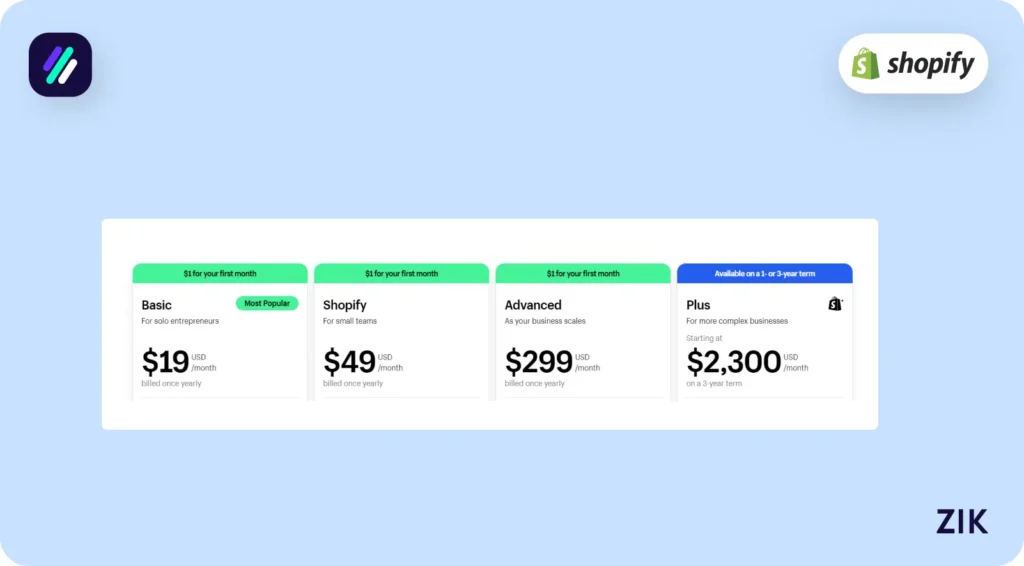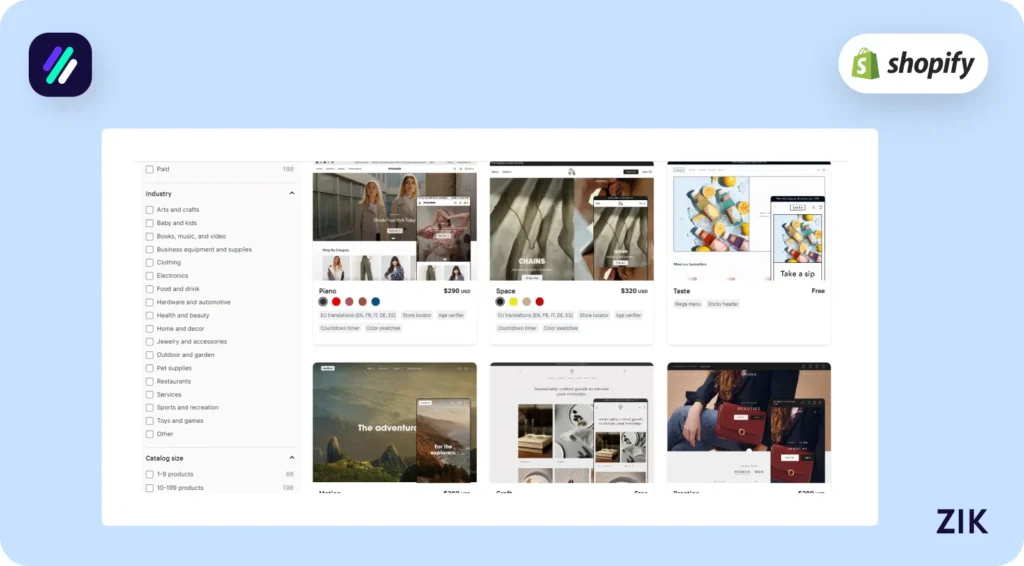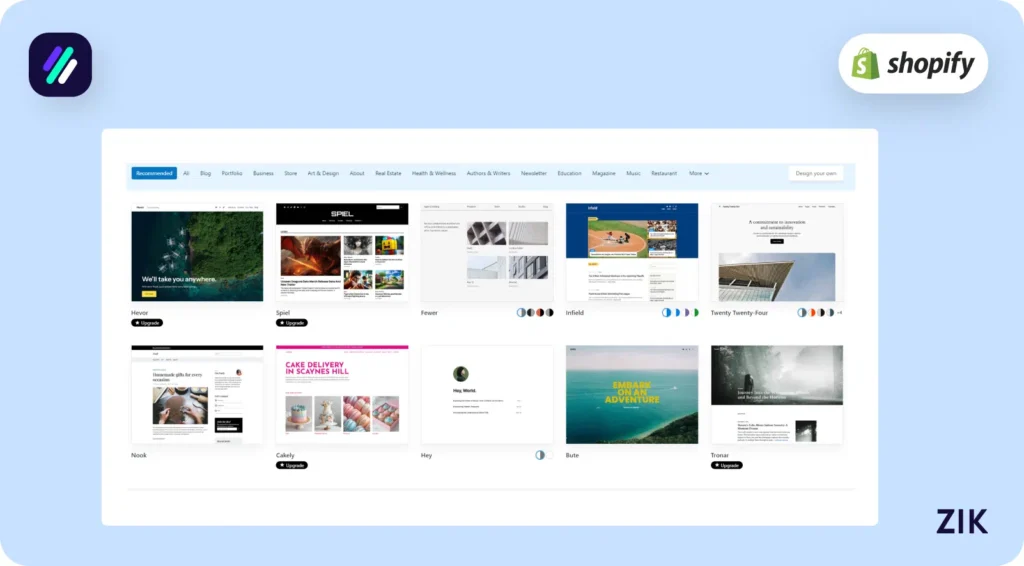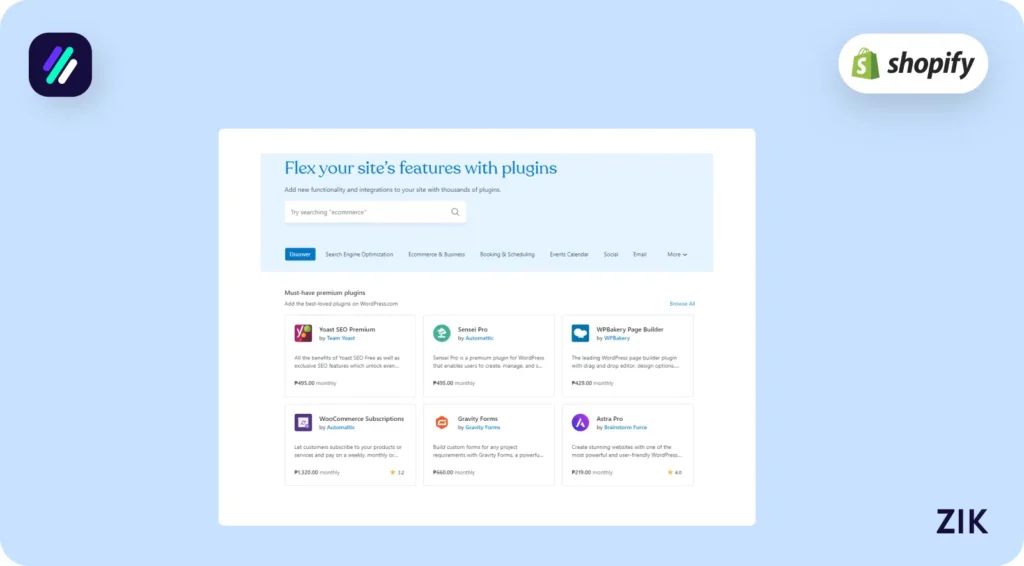Shopify vs WordPress dropshipping: Which should you use?
Once you embark on a dropshipping venture, the first thing to consider is which best ecommerce platforms to set up your online store. It is one decision that could impact the rest of your e commerce journey, so be sure to choose right!
Luckily, this guide on Shopify vs WordPress for dropshipping will break down the essential e commerce features and capabilities each ecommerce platform offers to help you make the right choice.
Shopify and WordPress are two of the biggest platforms for ecommerce functionality, commerce, and website solutions. With abundant features and solutions, how do you begin to pick?
Don’t be frustrated because I also had the same struggle when starting out as an ecommerce seller. There does not seem to be any difference from the outside, and they offer the same thing.
However, digging deeper reveals major differences crucial when aligning the right ecommerce platform for your business needs. Looking at store performance through the Shopify sales tracker can also show you how Shopify stores are actually converting compared to WordPress alternatives.
If you cannot decide which between Shopify vs WordPress to use for your online stores, you’ve come to the right place. Keep reading this WordPress Shopify comparison to find the solution you need that will help your e-commerce business thrive!

Key Takeaways
- Shopify is a complete ecommerce solution and website builder that makes it easy to set up your dropshipping store using a drag-and-drop feature.
- WordPress is a bit more complicated to set up due to the lack of built-in tools and ecommerce functionalities, thus requiring plugins and third-party integrations.
- Shopify pricing is more straightforward and transparent, whereas WordPress costs can be more difficult to compute since you have to pay for more plugins and hire a developer to build your website.
- Both platforms offer many options for third-party apps and payment processors for an ecommerce store.
Comparison of eCommerce Platform: Shopify vs WordPress for Dropshipping?
For this purpose of comparison between Shopify vs WordPress, I will take you to various ecommerce features and tools available to each platform that are suited for the dropshipping business model.
Whether it is your first time building a dropshipping online store or you want to expand to more online stores, this detailed comparison will give you a clearer idea of the right choice.
Website Setup & Ease of Use
Shopify is an e commerce platform equipped with tools that allow ecommerce store owners to build their own online store and launch it within minutes.
With various customization options, access to free and premium themes, app integrations, and web hosting, creating an online storefront for your dropshipping business that meets your branding requirements and your products is easy.
Shopify is easy to use. You can sign up for a free trial to get a ‘feel’ for the platform’s features. You can also choose pricing plans that suit your budget and expected sales volume.
Once you create an account, you can access your admin dashboard’s customization tools and selling features.
With WordPress, it’s a completely different process. Unlike Shopify, the first step is to purchase a domain name and hosting, where you can do all these steps from your dashboard after signing up.
You must secure your web hosting first and then install WordPress before you can set up your login details.

Unlike the Shopify dashboard, WordPress feels like a black canvas.
You must install plugins for every tool you need to integrate into your ecommerce store to enhance its functionality beyond what is standard on the platform. These third-party plugins include SEO, analytics, and ecommerce features, which are standard on Shopify.
Winner: Shopify. It is easy to use and straightforward even if it’s your first time using the platform, whereas WordPress has a bit of a learning curve.
eCommerce Features
The next and most important consideration when choosing between Shopify and WordPress is this: e-commerce capabilities.
If you want to start a Shopify dropshipping store online, Shopify is something that most sellers would lean towards because of its ecommerce focus. Shopify aspires to become the all-in-one solution for e commerce sellers, equipping them with tools designed to help a business thrive and grow.
It starts with an ecommerce website builder that provides tools like website customization and inventory management tools to build a functional ecommerce store. It also integrates with various sales channels to reach a wider audience for your dropshipping store.
Another advantage of Shopify is the point-of-sale (POS) solution, which allows online business owners to sell in person.
With WordPress it lacks the out-of-the-box e-commerce capabilities that Shopify offers. You must install a third-party commerce plugin, such as WooCommerce.
WooCommerce is an open-source tool that equips your online store with the essential features to sell and dropship online.
The only downside to integrating WooCommerce into the commerce functionality of your WordPress site is that it does not include the legal texts included upon setting up your websites, such as terms and conditions and data privacy declarations.
You must install a separate plugin for your WordPress site’s legal texts and requirements.
Winner: Shopify – Shopify is an ecommerce solution with basic to advanced ecommerce features you need to set up a dropshipping store. With WordPress, you must purchase and install those ecommerce features separately.
Pricing
Pricing is an important area to tackle when comparing Shopify vs. WordPress for dropshipping businesses. It is one aspect where there is a considerable difference between the two e-commerce platforms.
I’ve covered the Shopify pricing plans and the best dropshipping plans. But to give you an idea, there is a free trial option on Shopify. The free trial offer only lasts for three days, but you can pay $1 a month after the period ends.
Once that period ends, you can choose from any of the five pricing plans.
The Starter plan is available at $5 per month, but it won’t let you build a website, and you can only sell through various sales channels. The other pricing plans are priced as such:

- Basic – $25 per month
- Shopify – $65 per month
- Advanced – $399 per month
- Shopify Plus – $2,300 per month
It’s important to note that you can get a reduced monthly premium if you choose an annual membership (or you pay annually).
As expected, the features you can access will differ according to your Shopify plan. The higher the plan, the more features are available to your account.
This impacts your ability to customize your online store, the staff accounts you create, and the transaction fees. The higher tiered plans also provide access to more complex selling features, such as those for selling on international markets.
On the other hand, WordPress costs vary significantly. While setting up a Shopify dropshipping store is straightforward, and all the rates are published on the Shopify site, it’s a bit more complicated when setting up a WordPress site due to the number of variables.
There is a misconception that setting up an online store on WordPress is free. This is not the case, especially if you want to build a fully functional e-commerce store.
The WordPress content management system (CMS) is free, but a WordPress-powered e-commerce site is not.

First, you must pay for the hosting and domain name. The costs vary depending on where you buy them from. Also, consider that you must pay separately for WordPress hosting, and you’ll have two options for this.
The first option is shared hosting, which you must pay on a monthly subscription basis. The second option is managed hosting, which offers faster and more secure website hosting, although they are pricier than shared hosting plans.
Another cost involved when setting up your WordPress site is the theme. Free WordPress themes are available, but if you want to customize one for your dropshipping store, you must pay for premium themes.
You should consider the costs of the ecommerce integrations to your site since WordPress offers only limited options for ecommerce features. Be sure to budget for the WordPress plugins you must install on your site to add more ecommerce functionality.
Shopify offers a drag-and-drop website builder tool, but you don’t have that with WordPress. You have to budget to hire a professional developer to design your website!
Depending on how complex you want your website to be, this can range from affordable to expensive.
In addition to the abovementioned costs, ensure you have a budget for your WordPress site maintenance. This service ensures the security of your online store, which is an important investment for a business or professional WordPress site.
Winner: Shopify – Don’t let the pricing structure intimidate you because you could save in the long run with Shopify’s pricing than with WordPress, which requires you to purchase every element to build your store.
Get the eBook and learn how to launch your one-product Shopify store right!Store Design and Themes
Customizing and designing your online store is the most fun part of setting up your dropshipping store. So, how do Shopify and WordPress differ in this regard?
The Shopify Theme Store is dedicated to providing users access to themes to customize their store design. The themes are organized according to the niche, allowing you to pick the right theme for your brand or products easily.
There are 8 free themes available and over 60 premium themes, ranging from $120 to $180. If you cannot find a theme that suits your branding needs, there are many options for third-party Shopify themes.

The main advantage of using Shopify themes is that they are ready out of the box. This means that they can be easily integrated into your dropshipping store and are optimized and responsive to mobile devices.
If you’d like to see what themes top-performing Shopify stores are using, try the free Shopify Theme Detector by ZIK Analytics. It instantly reveals the theme name, layout details, and design inspiration behind any Shopify site
Once you select a theme, you can add customization using drag-and-drop functionality; no need to worry if you don’t have a coding background!

If you ever have trouble building your online dropshipping site, the Shopify technical support team is available 24/7 to help.
WordPress has up to 8,000 themes available, most of which have ecommerce functionalities.
However, unlike the Shopify premium and free themes, they require tweaking and editing to achieve the desired functionality and look for your dropshipping business.
If you don’t know how to do basic website editing or coding, you must hire a designer to complete the web development of your website.

Unlike Shopify, which has its own themes available through the Shopify Theme Store, themes for WordPress are created by third-party developers. You must contact the developer if you have issues using a particular theme.
Winner: Shopify. While WordPress offers many theme options, Shopify is easier to set up and customize, with drag-and-drop functionality and no coding required.
Payment Gateways
When dropshipping with Shopify vs WordPress, it’s essential to consider how to facilitate transactions when a customer purchases from your dropshipping store.
Shopify has its own built-in payment processor called Shopify Payments. Choosing this payment method provides you with perks, such as reduced or waived transaction fees.
But if you don’t want to use Shopify Payments, don’t fret because it accepts over 100 payment gateways if you prefer a third-party payment processor.
Adding a payment processor to your WordPress store requires setting it up through the WooCommerce plugin. Up to 75 payment gateways are available through WooCommerce, which is also good enough to accept payments for your dropshipping store.
Incorporating various payment processors into your dropshipping store is beneficial as you can provide many options for customers to pay using their preferred and most convenient method.
Winner: Shopify and WordPress offer extensive payment gateway options for dropshipping businesses.
Apps and Plugins
Access to apps and plugins is integral to building a functional ecommerce store. That’s why both Shopify and WordPress offer third-party integrations to allow store owners to personalize their store experience to suit their target audience and business goals.
The Shopify App Store offers up to 6,000 third-party apps for dropshipping stores built on the Shopify platform. These apps include Shopify email marketing campaigns, messaging apps, and product review plugins.

On the other hand, a comprehensive suite of WordPress plugins, over 50,000 plugins available for your store!

To be fair, Shopify requires fewer apps and plugins because it is designed to be easy and straightforward. In addition, Shopify has many built-in tools for ecommerce, marketing, analytics, and so on.
With WordPress, you need third-party apps and plugins to improve functionality, which explains the considerable difference in available apps and plugins.
Winner: Shopify – Shopify users are less reliant on ecommerce plugins, unlike WordPress, where most ecommerce features and functionalities are available only through plugins.
Dropshipping
Given that we’ve explored the differences between Shopify vs WordPress in various ecommerce functionalities, it’s time to put them to the real test. Which one is better for dropshipping?
Dropshipping is a thriving business model, so many online sellers want to jump at this popular model to gain more sales online. If you decide between Shopify and WordPress for dropshipping, you must know that both platforms can easily integrate with various dropshipping apps.
There is an option to automate adding products from dropshipping supplier websites to your ecommerce store, which can be helpful if you want to save time from manually adding and listing products to your storefront.
You can choose either Shopify or WordPress for dropshipping, but consider the various elements discussed above to help decide what fits your budget. Considering the ease of set-up is also crucial, based on your experience and expertise in building an online store.
Shopify is the best option if you don’t have time to learn how to build an ecommerce store from scratch. As a dedicated ecommerce solution, you have everything you need to get your website up and running in minutes!
Shopify and WordPress offer 24/7 customer support, so you need not worry if you get stuck. They will quickly respond to your queries!
Launch with Shopify AI Store Builder
Still deciding between Shopify vs WordPress? Skip the tech hassle—use the Shopify AI store builder to launch your store in under 10 minutes. This tool sets up your design, branding, and fills your store with proven best-sellers. No coding, no guesswork. Just pick your niche, customize your look, and go live with a fully optimized dropshipping store backed by real data.
Frequently Asked Questions on Shopify vs WordPress
Here are some frequently asked questions comparing Shopify and WordPress:
Which is better Shopify or WordPress?
It really depends on your priorities. Shopify is easier to set up, more reliable for non-techie users, and offers built-in hosting, security, and ecommerce features. WordPress + WooCommerce gives you more flexibility, control, and customization, but often requires more work with hosting, plugins, maintenance, and security.
Should I move from WordPress to Shopify?
You should consider moving from WordPress to Shopify if you want a simpler, fully hosted e-commerce solution with built-in payment processing, security, and support. However, if you rely heavily on customization, content management, or plugins, staying with WordPress + WooCommerce may be better.
Is it better to make a website or use Shopify?
If you want to sell products online quickly with built-in ecommerce tools, Shopify is often better since it handles hosting, payments, and security for you. Building a custom website offers more control and flexibility, but it requires technical skills, plugins, and ongoing maintenance.
What is the downside of Shopify?
The main downsides of Shopify are its monthly fees, extra costs for apps, and transaction fees if you don’t use Shopify Payments. Design flexibility is also limited without coding, and scaling stores often rely on paid apps or developers, which can increase overall expenses.
Is Shopify safer than WordPress?
Yes, Shopify is generally safer than WordPress for ecommerce because it’s a fully hosted platform with built-in SSL, PCI compliance, and automatic security updates. WordPress can be secure too, but it requires manual updates, plugins, and extra hosting security measures to maintain protection.
Can I move my website from WordPress to Shopify?
Yes, you can move your website from WordPress to Shopify using migration apps or a manual transfer. Tools like LitExtension or Cart2Cart help import products, customers, and orders. While the design won’t transfer directly, you can rebuild your theme in Shopify for a fresh storefront.
Can you sell on WordPress with Shopify?
Yes, you can sell on WordPress with Shopify by using the Shopify Buy Button or integration plugins. This lets you embed products, collections, or a shopping cart directly on your WordPress site while Shopify securely manages checkout, payments, and order processing in the background.
Do I need a business license for Shopify?
No, Shopify doesn’t require a business license to open a store. However, depending on your country, state, or the products you sell, local laws may require one. To stay compliant, always check regional business regulations before operating your Shopify store.
Can AI build a Shopify store?
Yes, AI can build a Shopify store using tools like the Shopify AI Store Builder and third-party apps. These generate product descriptions, images, and layouts automatically. While AI speeds up setup and design, human customization is still needed to refine branding and optimize conversions.
Which website is better than Shopify?
It depends on your priorities. If you care about full customization, low ongoing costs, and owning your code, WooCommerce (WordPress-based) is often considered better. If you want built-in enterprise features and no transaction fees, BigCommerce is a strong contender.
Want to review our other Shopify comparison articles?
Check out our comparisons of Shopify vs:
- Big Cartel
- BigCommerce
- Ecwid
- Magento
- Neto
- OpenCart
- osCommerce
- PrestaShop
- shopify plus
- Squarespace
- Volusion
- Weebly
- Wix
- WooCommerce
- WordPress













